Hair Removers
Hair, in one form or another, covers almost the entire surface of the body. Deciding what bits need removing is a matter of personal taste which, in turn, is influenced by changes in fashion. For example, leg and underarm hair was not usually removed before the 1920s because most women did not expose these parts of their body to public view. New fashions, such as higher hemlines, sleeveless dresses, the one-piece bathing suit, and the replacement of heavier cotton and woollen stockings with sheer silk all coincided with concerns – fuelled by advertising – about the perils of ‘unsightly’ underarm and leg hair.

Above: 1917 Sylvia Bremer [1897-1943] in a one-piece bathing suit.
Having made the decision to remove it, women could select from a wide variety of methods to get rid of it, their choice determined by factors such as availability, cost, convenience, the pain involved and whether a permanent or temporary solution was required. The position of the hair on the body was also a consideration. Removing leg or underarm hair required a different approach to eliminating a few stray hairs from between the eyebrows.
Depilation and epilation
Removing hair is known as depilation or epilation. Sadly, these terms have not been used consistently. For some, they are synonyms and can be used interchangeably; others use depilation for methods that remove hair temporarily and restrict the term epilation to processes, such as electrolysis, that result in permanent hair loss.
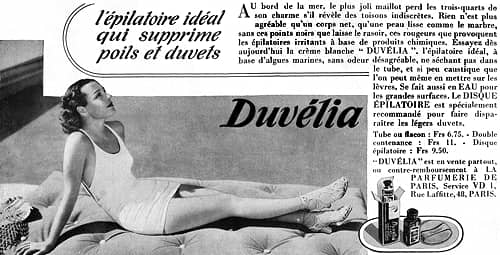
Above: 1938 La Parfumerie de Paris Duvélia. This French firm describes its hair-removing creams and abrasive discs as ‘les épilatoires’ rather than ‘les dépilatoires’.
The term epilation predates the introduction of electrolysis and this suggests that a better use for these terms is to based them on whether the whole or part of the hair is removed. Depilation then refers to practices that only remove the hair shaft showing above the skin which includes chemical depilatories, shaving and abrasives, all of which are necessarily temporary.
Epilation is then reserved for methods that remove the intact hair, including the hair bulb, such as tweezing and waxing which are temporary, as well as permanent procedures such as electrolysis and thermolysis. Clearly, whether temporary or permanent, if we use this definition, epilation has a more lasting effect than depilation.
| Depilation: | Chemical depilatories, shaving and abrasives. | |
| Epilation: | Tweezing/plucking, waxing, electrolysis, thermolysis and the blend. | |
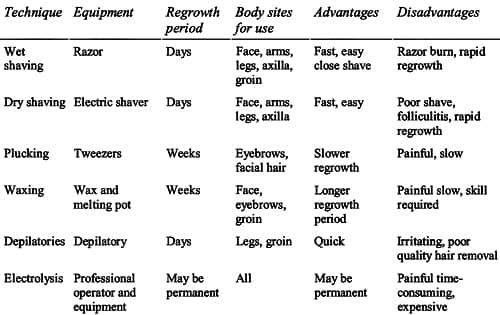
Above: Comparison of some hair removal treatments (Draelos, 2005, pp. 225-226).
Beauty Culture
Only some of the hair-removal methods listed above became established salon practices. The most popular home remedies for removing large amounts of hair, depilatories and shaving contrast with those normally carried out in beauty establishments. Salons usually preferred epilation treatments over depilation as the effects were longer lasting.
Depilation
Shaving: The introduction of the Gillette Safety Razor in 1903 made shaving easier and safer and Gillette went on to make versions for women starting with the Milady Décolleté Gillette in 1916. When the Gillette patent expired in 1921 this type of razor became dramatically cheaper and wet shaving went on to become the most common method used by women to remove leg hair. Understandably, shaving did not become a standard salon practices and, as far as I can tell, no cosmetic company ever sold razors or the dry electrical shavers that followed.
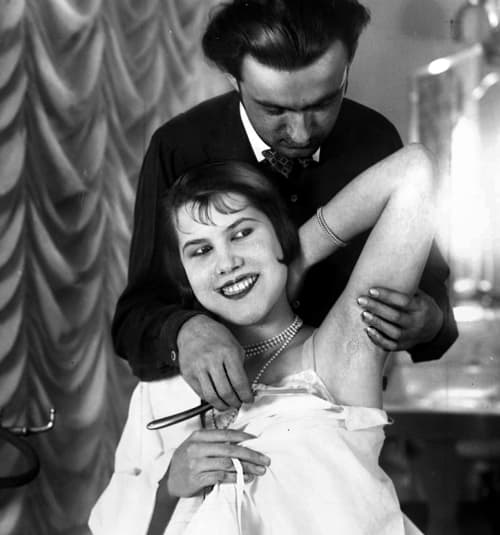
Above: 1930 Woman having her underarm shaved possibly by a barber.
Chemical depilatories: Chemical depilatories work by breaking down the keratin protein in the hair shaft thereby dissolving the hair at the surface of the skin. Despite the fact that early versions were very smelly and often irritated the skin, their simplicity meant that they were a very popular method of removing hair at home. They were also used in some salon treatments for superfluous hair, particularly on the face and many cosmetic companies included a version in their product list.
Marinello Depilatory is a dainty cosmetic which can be recommended to patrons for the removal of hair from the armpits or the arms and legs. It is a powder to be used in paste form, and whenever the prevailing mode dictates sleeveless gowns and stockingless bathing attire, it should always be kept before the attention of beauty shop patrons.
(The science of beautistry, 1932, pp. 416-417)
See also: Chemical Depilatories
Abrasives: Abrasives use a rough surface to remove hair in much the same way as sandpaper works to ‘sand’ wood. Some, like Bellin’s Wonderstoen were sold as discs, others as mitts or as discs with a handy strap into which the hand would fit.
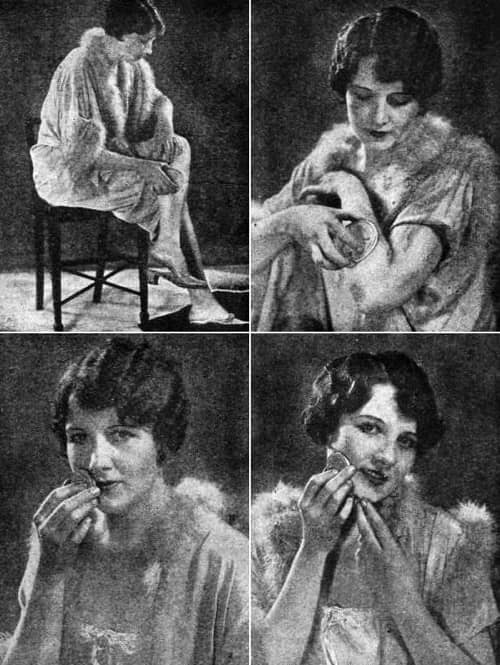
Above: Bellin’s Wonderstoen used on the legs, arms upper lip, and cheeks to remove superfluous hair.
Abrasive mitts should not be confused with rough-textured mitts – such as the one mentioned below by Elizabeth Arden – which were designed to exfoliate skin rather than remove hair.
Velva Bath Mit, a rough-textured cloth Mit tightly packed wirth soap grains and boasting a strap to slip your hand through. A perfect shower-bath soap.
(Elizabeth Arden advertisement, 1942)
Although never very popular, the use of abrasives increased in the 1940s when both stockings and cosmetics were in short supply. An abrasive mitt or something similar could be used in place of a chemical depilatory if these were also hard to get due to war shortages. Abrasives were also useful in rubbing off loose skin before applying a cosmetic stocking, although a good scrubbing brush or pumice stone would work just as well.
See also: Cosmetic Stockings
Epilation
Tweezing/plucking: This is one of the earliest and simplest method for removing hair and has remained a staple salon treatment right through to the present day. Early Beauty Culturists used forceps purchased from a medical supplier. These were used by doctors for a range of medical procedures including removing fungal infected hair.
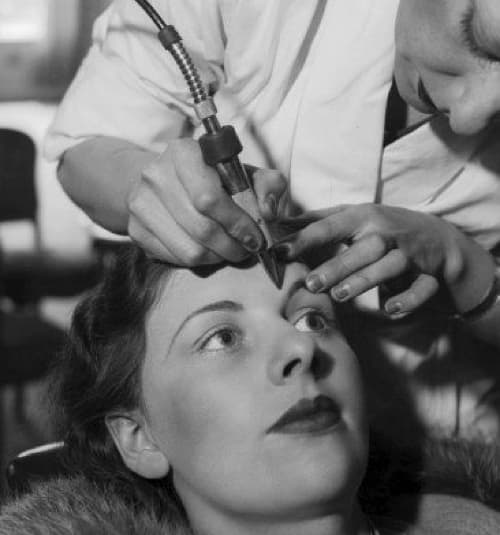
Above: Electrical tweezers were available in the 1930s. I doubt it could remove hair more quickly than a skilled aesthetician using ordinary tweezers.
A lot of facial hair that use to be removed by tweezing, such as eyebrow shaping, could also be removed by waxing but a skilled aesthetician can achieve the same result in a similar time frame by tweezing. This avoids any possibility of burning the skin and leaves the vellus hair intact which keeps the soft skin bloom and avoids the ‘flat’ look that waxing produces.
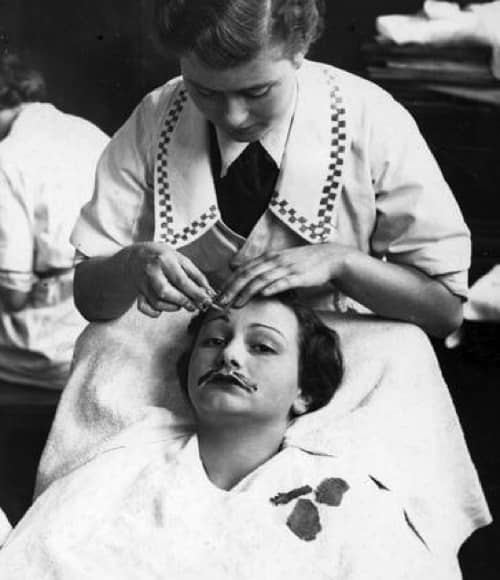
Above: Facial treatment plucking hair from the eyebrows and waxing the upper lip. The wax strips on the coverall suggest that hair has already been removed from other parts of the face (VADS).
Waxing: I can find no evidence that waxing was a common salon practice before the First World War either on the face or on any other part of the body. This does not means that this type of treatment was not used in salons. Wax-resin compositions have been used to remove hair for millennia. however, it seems likely that most salons used a chemical depilatory, bleached or plucked hair, or removed it permanently with electrolysis.
By the 1920s, using wax to remove hair had become a more common salon treatment with companies like Dorothy Gray, Elizabeth Arden and Helena Rubinstein were also retailing home-based waxing kits, joining others that had been on the market earlier than this.
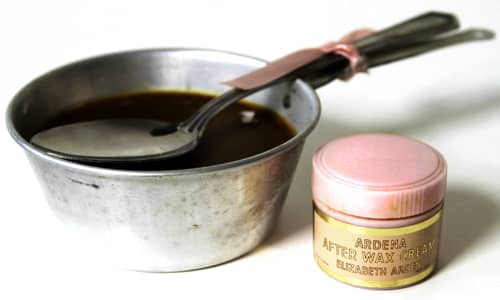
Above: Wax Pot and Arden After Wax Cream from the Elizabeth Arden Ardena Electra-Eradicator Kit.
The main reason for this changed was the increased interest in removing leg and underarm hair and it is not surprising that advertising for these salon treatments was more common in spring and summer when women were more concerned about how they would look in bathing costumes and summer dresses.
Hairy legs are the most common trouble.
They look horrible with your swim suit, or when you are sunbathing or playing tennis.
The loveliest, most expensive stockings cannot hide the hairs, which show through.
You can never completely destroy hair growth. But you can keep it under control, attack it and weaken it, so that the growth becomes slow and fine.
Naturally when a largish surface, like legs and arms, has to be dealt with, the process may be rather different from that when only the removal of a few downy hairs on an upper lip is in question.
But there is one method which is equally applicable whatever part of the body is to be treated. It is the electra-wax eradicator of a very famous specialist, and has been used with unqualified success for some years, both in her salons and by her clients at home.
It is absolutely safe and non-injurious to the skin: it discourages the recurrence and weakens the growth of hair, and it is much more lasting in effect than any depilatory, which only removes the hair from the surface of the skin.(Elizabeth Arden advertorial, 1935)
See also: Waxing
Electrolysis: Using electrolysis to permanently remove hair was first developed as a medical procedure after Major Charles Eugene Michel [1833-1913] published details of his technique in 1875.
When medical suppliers began manufacturing electrical kits containing all the materials required to conduct electrolysis treatments the practice was taken up by lay persons and quickly became an important treatment offered in many beauty establishments.
See also: Electrolysis
Salon-based companies that started out without this service, such as Helena Rubinstein, later added it. It is also likely that some women who started by operating an electrolysis business later branched out and began offering other beauty services including selling their own cosmetics. Marie Earle and Mrs. Pomeroy may have started this way.
See also: Marie Earle and Mrs. Pomeroy
Thermolysis and the Blend: Like electrolysis, thermolysis also started out as a medical procedure. The early machines were difficult to use so thermolysis was not taken up by Beauty Culture in any major way until the 1930s and 1940s when vacuum-tubes replaced ‘spark-gaps’ in high-frequency machines, making them a lot simpler to operate.
The so-called Blend technique which combined thermolysis and electrolysis was developed within the beauty industry by Henri E. St. Pierre [1891-1974] and Arthur Hinkel [1916-1993]. Although St. Pierre experimented with the technique in the 1930s it was only after the Second World War that machines developed by Hinkel became widely available.
See also: Thermolysis and the Blend
Other techniques
The measures described above are by no means the only hair-removal methods that have been used over the years or are in use today. In the past X-rays have unfortunately been employed to remove hair, by the medical profession and by lay practitioners.
See also: X-rays and Hair Removal
More recently, some salons in the West have introduced threading, a technique long practiced in the Middle East and elsewhere and there are now clinics operating that remove hair using lasers.
First Posted: August 6th 2019
Last Update: 14th October 2023
Sources
deNavarre, M. G. (1941). The chemistry and manufacture of cosmetics. Boston, MA: D. Van Nostrand Company, Inc.
Draelos, Z. D. (2005). Hair care: An illustrated dermatologic handbook. New York: Taylor & Francis.
Herzig, R. M. (2015). Plucked: A history of hair removal. New York: New York University Press.
Klarmann, E. G. (1962). Cosmetic chemistry for dermatologists. Springfield, IL: Charles C. Thomas.
The science of beautistry. (1932). New York: The National School of Cosmeticians, Inc.
The skin: Its care and treatment, according to the Michaud system. (1903). Chicago: McIntosh Battery & Optical Company.
Squire, B. (1893). Superfluous hair and the means of removing it. London: J. & A. Churchill.
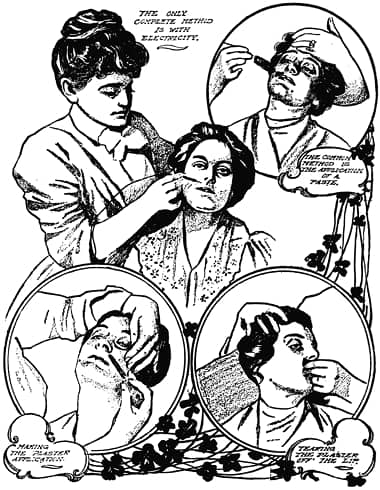
1901 Removing facial hair by depilatory past (top), electrolysis (middle) or wax plaster (bottom).

1916 Milady Décolleté Gillette.
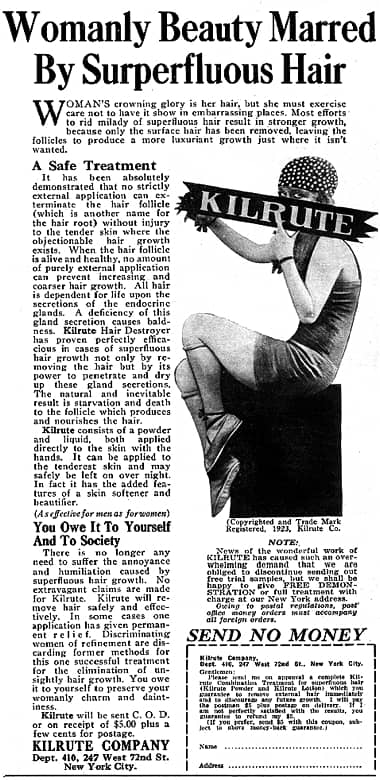
1923 Kilrute Depilatory.
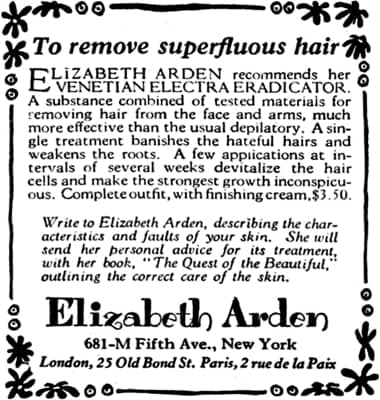
1924 Elizabeth Arden Venetian Electra Eradicator.
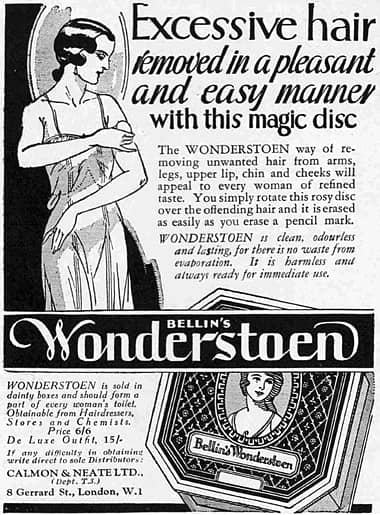
1930 Bellini Wonderstoen.

1930 Dulmin (Germany).

1931 Delatone Depilatory.
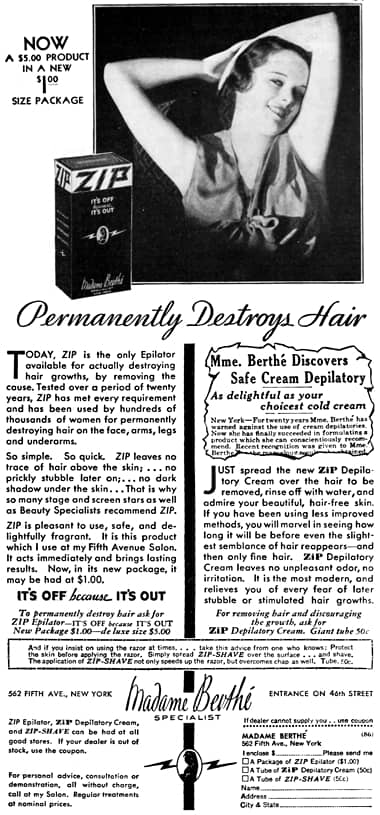
1931 Madame Berthé Zip Epilator and Depilatory.

1933 Marchland Golden Hair Wash. For women with light hair bleaching could be a good solution.
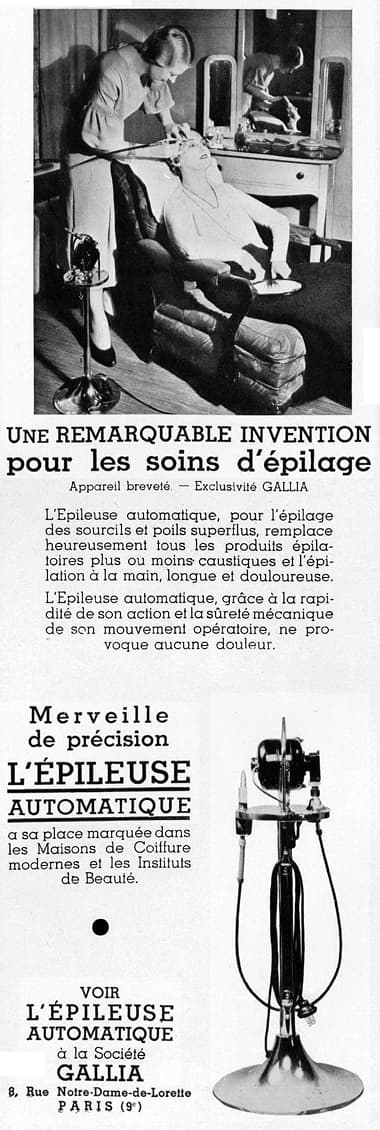
1934 Gallia L’Epileuse Automatique (France)
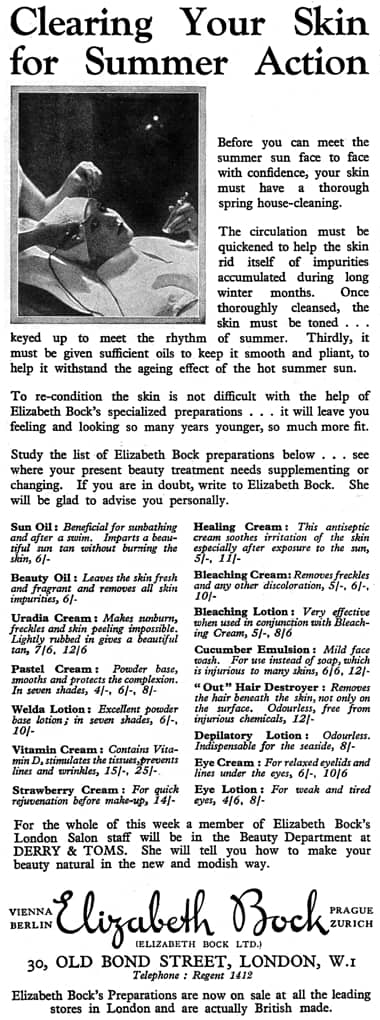
1934 Elizabeth Bock salon offering electrolysis treatments as well as ‘Out’ Hair Destroyer (possibly a wax) and Depilatory Lotion.
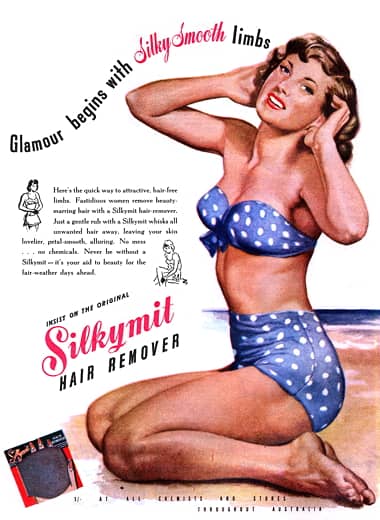
1949 Silkymit, an abrasive hair remover.

1957 Princess Remington electric dry shaver.
